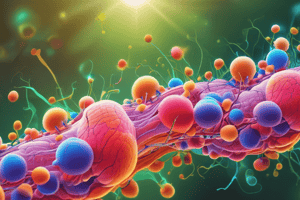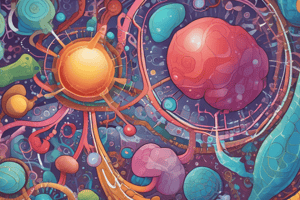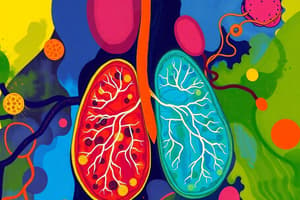Podcast
Questions and Answers
What is the primary role of ATP in cells?
What is the primary role of ATP in cells?
- To provide energy for cellular activities (correct)
- To synthesize proteins
- To store genetic information
- To transport molecules across the cell membrane
Glycolysis requires oxygen to break down glucose into pyruvic acid.
Glycolysis requires oxygen to break down glucose into pyruvic acid.
False (B)
What two molecules transport hydrogens to the cristae of the mitochondria?
What two molecules transport hydrogens to the cristae of the mitochondria?
NADH and FADH2
The process of converting fatty acids to acetyl-coA is called ______.
The process of converting fatty acids to acetyl-coA is called ______.
Match the following vitamins with their primary function:
Match the following vitamins with their primary function:
Which of the following processes occurs in the cytoplasm?
Which of the following processes occurs in the cytoplasm?
The absorptive state occurs when glucose levels are low and the body needs to raise them to continue cellular respiration.
The absorptive state occurs when glucose levels are low and the body needs to raise them to continue cellular respiration.
What process uses energy released from passing hydrogens down the electron transport chain to make 32 ATP?
What process uses energy released from passing hydrogens down the electron transport chain to make 32 ATP?
Excess glucose molecules are delivered to the liver and skeletal muscles for conversion to the polysaccharide, ______ (glycogenesis).
Excess glucose molecules are delivered to the liver and skeletal muscles for conversion to the polysaccharide, ______ (glycogenesis).
Match the following minerals with their functions:
Match the following minerals with their functions:
Which of the following best describes the role of insulin?
Which of the following best describes the role of insulin?
The Krebs cycle results in a net gain of 32 ATP molecules.
The Krebs cycle results in a net gain of 32 ATP molecules.
What two products are produced when adipose cells break down fats?
What two products are produced when adipose cells break down fats?
The amount of energy required to maintain the body's functions per unit of time is referred to as the ______ (BMR).
The amount of energy required to maintain the body's functions per unit of time is referred to as the ______ (BMR).
Match the following hormones with their gland of origin:
Match the following hormones with their gland of origin:
During cellular respiration, what is the final acceptor of hydrogens in the electron transport chain (ETC)?
During cellular respiration, what is the final acceptor of hydrogens in the electron transport chain (ETC)?
Amino acids are absorbed into the lacteals and travel through the lymphatic system to be returned to the blood.
Amino acids are absorbed into the lacteals and travel through the lymphatic system to be returned to the blood.
What is the process by which glycogen in the liver is broken down into glucose and released into the blood?
What is the process by which glycogen in the liver is broken down into glucose and released into the blood?
After deamination of an amino acid, the toxic nitrogen waste product ______ is formed.
After deamination of an amino acid, the toxic nitrogen waste product ______ is formed.
Match the B vitamin with its part in key enzyme or process
Match the B vitamin with its part in key enzyme or process
Flashcards
Adenosine Triphosphate (ATP)
Adenosine Triphosphate (ATP)
The main source of energy for all cells, used to power cellular activities.
Building blocks for ATP
Building blocks for ATP
Adenosine Monophosphate and Phosphate Groups.
Cellular Respiration
Cellular Respiration
The process of breaking down glucose in the presence of oxygen to produce carbon dioxide, water, and energy (ATP).
ATPase
ATPase
Signup and view all the flashcards
Glycolysis
Glycolysis
Signup and view all the flashcards
Krebs Cycle (KC)
Krebs Cycle (KC)
Signup and view all the flashcards
Electron Transport Chain (ETC)
Electron Transport Chain (ETC)
Signup and view all the flashcards
Reduced (Acceptor)
Reduced (Acceptor)
Signup and view all the flashcards
Oxidized (Acceptor)
Oxidized (Acceptor)
Signup and view all the flashcards
Absorptive State
Absorptive State
Signup and view all the flashcards
Post-Absorptive State
Post-Absorptive State
Signup and view all the flashcards
Glycogenesis
Glycogenesis
Signup and view all the flashcards
Lipogenesis
Lipogenesis
Signup and view all the flashcards
Deamination
Deamination
Signup and view all the flashcards
Glycogenolysis
Glycogenolysis
Signup and view all the flashcards
Mobilization of fats
Mobilization of fats
Signup and view all the flashcards
Ketogenesis
Ketogenesis
Signup and view all the flashcards
Gluconeogenesis
Gluconeogenesis
Signup and view all the flashcards
Beta-oxidation
Beta-oxidation
Signup and view all the flashcards
Basal Metabolic Rate (BMR)
Basal Metabolic Rate (BMR)
Signup and view all the flashcards
Study Notes
- Individuals require food as a source of energy for all cells.
- Cells require energy for all activities except diffusion and osmosis.
- They produce energy in the form of adenosine triphosphate (ATP).
ATP Composition
- Building blocks for making ATP: adenosine monophosphate (AMP) and phosphate groups
- These building blocks come from food sources.
- AMP is a nucleotide derived from eating RNA.
- Phosphates are plentiful in a variety of foods.
- Cells can store adenosine diphosphate (ADP) for some time because it is relatively stable.
- Energy is needed to attach the third phosphate to ADP to make ATP.
- The third phosphate is attached to ADP with a high-energy bond.
Cellular Respiration
- Cellular respiration provides the energy to attach the third phosphate onto ADP.
- During cellular respiration, glucose (most often) is broken down into carbon dioxide and water in the presence of oxygen.
- Some of the energy is lost as heat energy, which warms the body but cannot be used by cells for work.
- Enough energy is released from glucose breakdown to make 36 ATP molecules used wherever work needs to be done in the cell.
- The enzyme ATPase breaks the high-energy bond holding the third phosphate of ATP, releasing energy to do work.
- ATP molecules produced during cellular respiration power all cells to stay alive, maintain homeostasis, repair, synthesize proteins, perform active transport, and undergo mitosis.
- They also enable each differentiated cell to perform its unique tasks.
Stages of Cellular Respiration
- Glycolysis: Glucose is broken down into two 3-carbon molecules: pyruvic acid or pyruvate.
- Glycolysis is a multistep process in the cytoplasm, does not require oxygen (anaerobic), and results in a net gain of only 2 ATPs.
- 4 of the 12 hydrogens from glucose are removed.
- Krebs Cycle (KC): 2 pyruvic acids and 4 hydrogens undergo further processing in the mitochondria, in the central matrix.
- The first 3-carbon pyruvic acid is converted to a 2-carbon molecule called acetyl coenzyme A, forming one CO2 molecule and removing one hydrogen.
- Acetyl-coA breaks down in a multistep process making 2 extra CO2 molecules and removing 3 more hydrogens (total of 3 CO2 molecules and 4 hydrogens removed from the first pyruvic acid).
- The second pyruvic acid is processed the same way, producing 3 more CO2 molecules and 4 more hydrogens.
- 8 hydrogens removed during the Krebs cycle, plus 4 from glycolysis, results in all 12 hydrogens from the original glucose being transported to the cristae of the mitochondria where the ETC takes place.
- Most hydrogens are brought to the cristae by hydrogen acceptors/carriers NADH and FADH2, yielding a net gain of only 2 ATPs during the Krebs cycle.
- Electron Transport Chain (ETC): Source of the remaining 32 ATPs produced during CR, along the inner membranes of the mitochondria called cristae.
- Each of the 12 hydrogens (with their electrons) are brought to the ETC by NADH and FADH2.
- As they pass along acceptors/carriers (cytochromes) on the cristae, energy is released with each transfer from one acceptor to the next and used to make 32 ATPs via chemiosmosis.
- An acceptor (carrier) that takes a hydrogen (and its electron) becomes reduced, and when it passes it to the next acceptor, it becomes oxidized.
- The entire process of passing 12 hydrogens (and their electrons) down the ETC is called an oxidation-reduction or "redox" chain.
- The final hydrogen acceptor along the ETC is oxygen.
- Each oxygen takes 2 hydrogens at a time to produce a water molecule (H2O), so 6 oxygens are needed to take 12 hydrogens, forming 6 H2O molecules as products of the ETC.
Absorptive State
- Cellular respiration must occur every second in a cell's life to provide ATP for survival, whether in the absorptive state (food being absorbed during mealtime with a surplus) or the post-absorptive state (resources are short, glucose levels dropping).
- It lasts for 4 hours during/after mealtime when glucose levels are high.
- Insulin primarily regulates the body's responses.
Carbohydrates in Absorptive State
- Glucose molecules are absorbed into the superior mesenteric capillaries and delivered to all cells for CR and carbohydrate synthesis.
- The liver can convert any monosaccharide to glucose.
- Excess glucose molecules are delivered to the liver and skeletal muscles for conversion to glycogen (glycogenesis).
- Still excess glucose molecules are delivered to adipose tissues for conversion to fat (lipogenesis).
Lipids in Absorptive State
- Glycerol and fatty acids are absorbed into the cells of the intestinal mucosa.
- There, they are recombined into triglycerides, coated with protein to become water-soluble chylomicrons.
- Chylomicrons are absorbed into the lacteals and travel through the lymphatic system to the blood.
- Some chylomicrons remain in the blood, while others are delivered to adipose tissue and converted to fat (lipogenesis).
Proteins in Absorptive State
- Amino acids are absorbed into the superior mesenteric capillaries and delivered to all cells for protein synthesis.
- Excess amino acids are delivered to the liver, where they are deaminated (amino group removed).
- The remaining amino acid molecule is converted to fat (lipogenesis).
- After deamination, ammonia (NH3) is formed, which is toxic.
- The liver converts most ammonia to urea before releasing both into the blood for removal by the kidney.
Nucleic Acids in Absorptive State
- Nucleotides from RNA and DNA are absorbed into the superior mesenteric capillaries and delivered to all cells for RNA/DNA synthesis and repair (and ATP).
Post-Absorptive State
- Occurs after 4 hours after mealtime when glucose shortages begin.
- The goal is to raise glucose levels so that CR continues and to provide substitutes for glucose in CR.
- Since CR continuation is critical for survival, hormones from numerous glands help the body respond: glucagon (pancreas), glucocorticoids like cortisol (adrenal cortex), growth hormone (anterior pituitary gland), thyroxine or T4 and triiodothyronine or T3 (thyroid gland), and epinephrine (adrenal medulla).
Carbohydrates in Post-Absorptive State
- Glycogen in the liver and skeletal muscles is broken down to glucose and released into the blood for all cells to use.
- This process is referred to as glycogenolysis.
Mobilization of Fats
- Adipose cells break down fats into glycerol and fatty acids, releasing them into the blood.
- Chylomicrons are broken down by plasma enzymes into glycerol and fatty acids.
- Some glycerol is converted to glucose by the liver (gluconeogenesis) and released for all cells to use in CR.
- Some glycerol can be absorbed directly by cells and converted to pyruvic acid for CR.
- Fatty acids are converted to ketones (keto-acids) by the liver and released.
- Most cells absorb ketones and convert them to acetyl-coA for CR.
- The process of converting fatty acids to acetyl-coA is called beta-oxidation.
Proteins in Post-Absorptive State
- Amino acids are deaminated by the liver to form NH3 and urea.
- The remainder of each amino acid molecule is converted to glucose (gluconeogenesis) for all cells to use in CR.
Vitamins and Minerals
- Vitamins and minerals provided in food play important roles in metabolic reactions.
Fat-Soluble Vitamins
- A: Maintains epithelia and is needed for the synthesis of visual pigments.
- D: Needed for normal bone growth via calcium and phosphorus absorption.
- E: Antioxidant.
- K: Used for the synthesis of clotting proteins.
Water-Soluble Vitamins
- B1 (thiamine): Coenzyme leading to the Krebs cycle.
- B2 (riboflavin): Part of FAD.
- Niacin: Part of NAD.
- B6 (pyridoxine): Coenzyme in amino acid, lipid metabolism, protein synthesis, antibody and nucleic acid synthesis.
- Folacin (folic acid): Coenzyme in amino acid, nucleic acid synthesis, metabolism, and blood cell production.
- B12 (cobalamin): Coenzyme in nucleic acid metabolism, carbohydrate and fat metabolism, and RBC production.
- Biotin: Coenzyme leading to the Krebs cycle, amino acid and fatty acid metabolism, and nucleic acid synthesis.
- Pantothenic acid: Part of acetyl-coA.
- C (ascorbic acid): Coenzyme for amino acid metabolism, collagen production, promotes Fe absorption, synthesis of steroid hormones from cholesterol, and is an antioxidant.
Minerals
- Na (sodium) and K (potassium): Nerve and muscle function.
- Cl (chlorine): pH and water balance.
- Ca (calcium): Nerve, muscle, hemostasis, and skeletal function.
- P (phosphorus): ATP, creatine phosphate, nucleotides, and skeletal functions.
- Mg (magnesium): Membrane functions, cofactor for enzymes, and bone formation.
- S (sulfur): Component of hormones, vitamins, and many proteins.
- Fe (iron): Hemoglobin, myoglobin, and cytochromes.
- Zn (zinc): Cofactor for more than 70 enzymes, like carbonic anhydrase, and contributes to growth and taste.
- Cu (copper): Hemoglobin synthesis, cytochromes, and melanin.
- Mn (manganese): Cofactor for enzymes, hemoglobin synthesis, urea formation, and activation of ATPase.
- F (fluorine): Bones and teeth.
- Co (cobalt): Part of vitamin B12, erythropoiesis.
Basal Metabolic Rate (BMR)
- BMR is the energy required to maintain the body's functions per unit of time.
- Measure under basal conditions: awake, at rest, room temperature, no exercise for 2-3 hours, and no food for 12 hours.
- Oxygen consumption/min. measures how much CR occurs per minute under basal conditions.
- Unit of energy used in BMR: Calorie (vs. calorie).
- When 1 liter of O2 is breathed to oxidize an average mixture of food (carbohydrates, lipids, and proteins), 4.825 Calories are consumed.
- Under basal conditions, ~14L of O2 are breathed/hr. and ~70 Calories/hr. are consumed (14L x ~5 Calories).
- To maintain the body for a day (24 hrs.), ~1680 Calories (24 hrs. x 70 Calories) are needed to provide enough energy to carry out basic functions (basal conditions).
- Temperature Regulation: Body heat from cellular respiration.
- To raise body temperature when it's too low: Shiver and constrict superficial blood vessels.
- To lower body temperature when it's too high: Sweat and dilate superficial blood vessels.
Studying That Suits You
Use AI to generate personalized quizzes and flashcards to suit your learning preferences.




